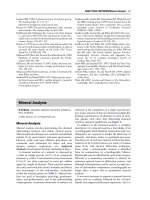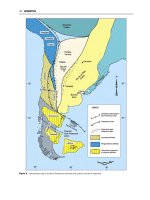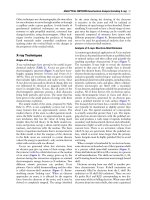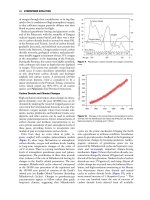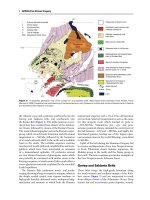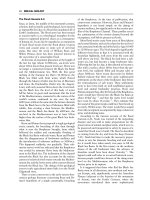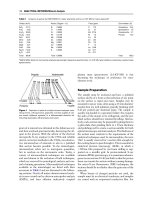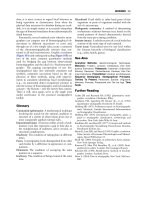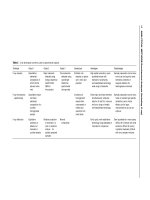Encyclopedia of geology, five volume set, volume 1 5 (encyclopedia of geology series) ( PDFDrive ) 416
Bạn đang xem bản rút gọn của tài liệu. Xem và tải ngay bản đầy đủ của tài liệu tại đây (92.22 KB, 1 trang )
CONSERVATION OF GEOLOGICAL SPECIMENS 377
allow such growth. When an infestation is encountered
the steps to take are:
.
.
.
.
confine it;
stop its growth;
eradicate it; and
prevent it from reoccurring.
Reduced Oxygen Environments
Reduced oxygen environments are cost-effective lowimpact methods of controlling the deterioration of
specimens that are sensitive to oxygen, water vapour,
or pollutants. Any rock or mineral specimen that is
sensitive to oxygen, water vapour, or pollutants (such
as rocks containing pyrite that is likely to oxidize or
has begun oxidizing) can be stored in reduced oxygen
environments to prolong their life. There are three
components to a reduced oxygen environment: an
oxygen scavenger or oxygen-purging system; an
oxygen monitor; and a barrier film. Oxygen scavengers are composed of either iron filings or molecular
sieves such as zeolite or mordenite. The optimum
composition of a barrier film for this purpose is currently under research. Commercially available films
are currently composed of materials chosen to suit
either the food or the electronics industries, and,
whilst these films may be useful for preventive conservation, they may not be the optimum. Barrier films are
layered polymers combined to produce a film with
good tear strength, low water migration, and low
oxygen migration. The enclosure is made by wrapping
the specimen in the barrier film and using a heat sealer
to close the film and finish the encapsulation. The
specimen should be supported in conservation grade
materials to ensure that no physical stresses are imposed on the specimen and no damage is created by
the abrasion of the film on its surface (Figure 3).
Remedial Conservation
Remedial conservation consists mainly of direct
action carried out on an object with the aim of
retarding further deterioration.
One of the most important and sometimes controversial stages of conservation treatment is surface
cleaning. Irreversible damage can occur if inappropriate treatments are used. However, the removal from
the surface of the object of contaminants or old consolidants that may otherwise cause harm is highly
advantageous. For example dust can contain acidic
particles that can cause surface damage. In some cases
cleaning may also clarify an object’s detail or reveal
unseen damage that can be treated subsequently.
Joins that require repair also have to be surface
cleaned to improve the final bond. There are many
types of surface-cleaning techniques available to
the conservator, and they tend to be divided into
mechanical cleaning and chemical cleaning.
Surface Cleaning: Mechanical
Abrasive Abrasive cleaning methods include all
techniques that physically abrade the fossil surface
to remove contaminants or coatings. Such techniques
involve the use of materials that impact or abrade
the surface under pressure, or abrasive tools and
equipment. The use of water in combination with
abrasive powder may also be classified as an abrasive
cleaning method. Depending on the manner in which
Color
Image
Figure 3 Pyritised ammonite encapsulated in barrier film in an oxygen free environment.

